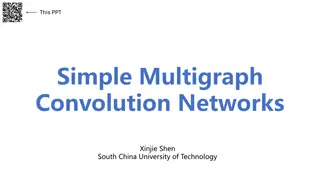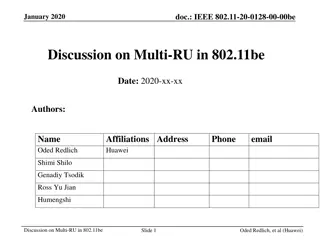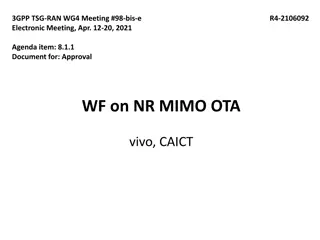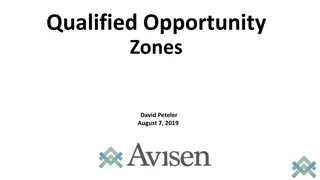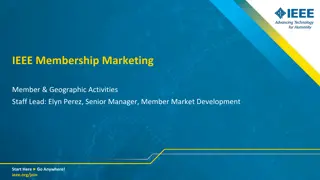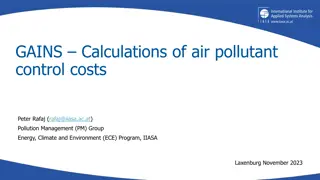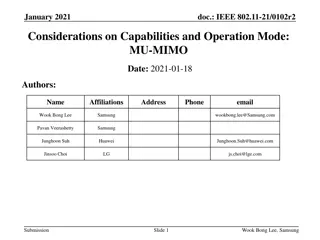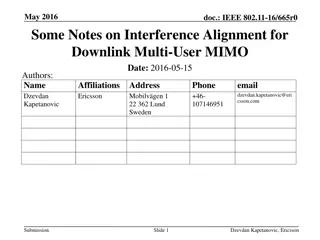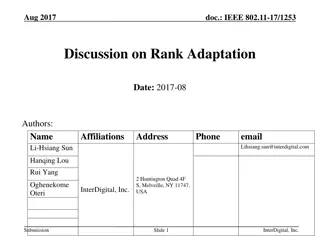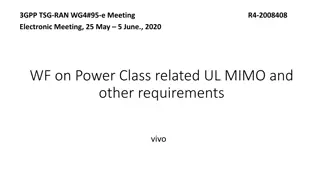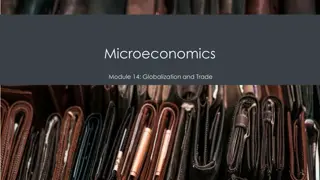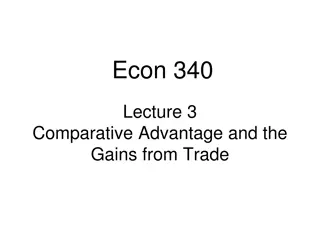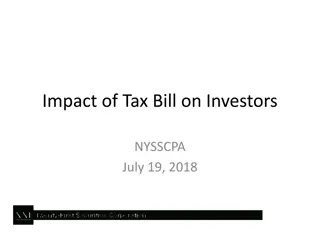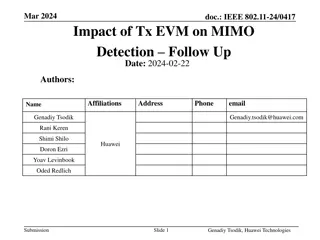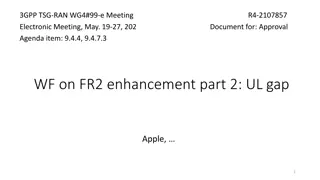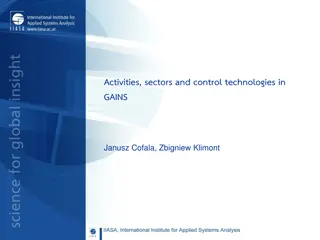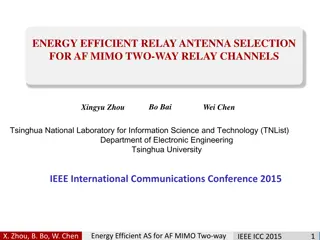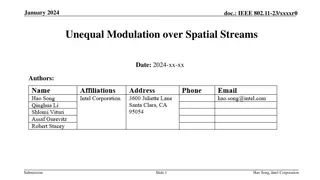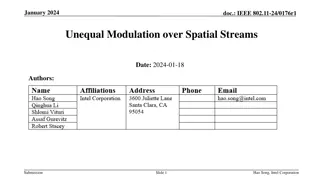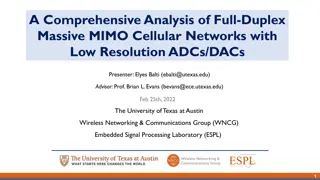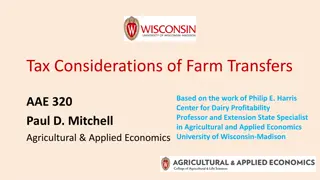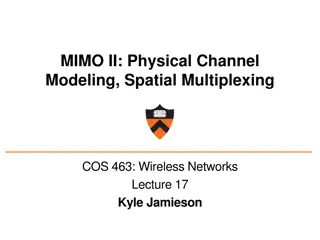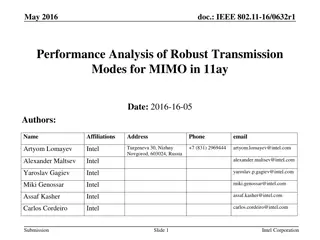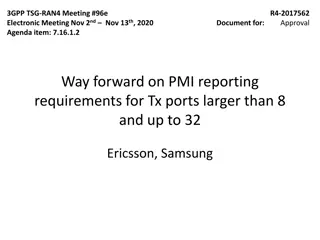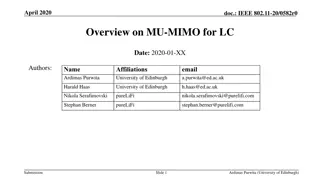Understanding Coordinated Beamforming and MU-MIMO in IEEE 802.11-23/1998r0
This document delves into the intricacies of Coordinated Beamforming (Co-BF) and MU-MIMO techniques in the context of IEEE 802.11-23/1998r0 standard. It explores the concept of nulling in Co-BF, handling more Rx antennas than streams, Zero-Forcing precoding to eliminate Multi-User Interference (MUI)
2 views • 22 slides
Advancements in Simple Multigraph Convolution Networks by Xinjie Shen
Explore the latest innovations in simple multigraph convolution networks presented by Xinjie Shen from South China University of Technology. The research evaluates existing methods, such as PGCN, MGCN, and MIMO-GCN, and introduces novel techniques for building credible graphs through subgraph-level
3 views • 6 slides
Overview of RAN Rel18 Package and Projects
Explore the RAN Release 18 package which includes RAN1-led, RAN2-led, and RAN3-led projects focusing on a variety of enhancements for next-generation networks. Projects cover areas such as MIMO evolution, AI/ML, NR positioning, network energy savings, mobility enhancements, IoT support, and more. Di
5 views • 7 slides
Rate Optimization in Wideband RIS-assisted Wireless Systems
This research focuses on rate optimization in wideband RIS-assisted wireless systems, specifically investigating MIMO RIS-assisted systems in sub-6 GHz mmWave settings. Pathloss and blockage modeling, along with LOS vs. spectral efficiency and RIS-UE distance vs. spectral efficiency analyses, are ke
0 views • 4 slides
Discussion on Multi-RU Allocation in IEEE 802.11be Standard
In January 2020, a discussion took place on the allocation of multiple Resource Units (RUs) to a single Station (STA) in the IEEE 802.11be standard. The proposal suggested categorizing RUs into small and large types, avoiding aggregation across multiple 20MHz channels. It emphasized assigning a sing
2 views • 29 slides
Approval and Validation Updates for NR MIMO OTA in 3GPP TSG-RAN.WG4 Meeting
The 3GPP TSG-RAN.WG4 Meeting discussed approval for the NR MIMO OTA workplan, addressed FR2 blocking issues, and emphasized the use of polarized antenna models. Updates were made to the power validation procedure and gNB beams usage criteria for FR1 MIMO OTA channel model validation. Collaboration w
1 views • 8 slides
Discussion on Enabling MIMO in IMMW: IEEE 802.11-23/1991
Enabling MIMO in mmWave technology is essential for improving throughput performance. While IEEE 802.11ad supports single-stream communications, 802.11ay introduces SU-MIMO, MU-MIMO, and hybrid beamforming. This document discusses the necessity of MIMO in IMMW and explores various MIMO options for e
2 views • 12 slides
Understanding Qualified Opportunity Zones Tax Benefits
Qualified Opportunity Zones (Opportunity Zones) offer tax incentives to investors who reinvest capital gains in designated low-income communities. By utilizing Qualified Opportunity Funds (QOF), investors can benefit from capital gains deferral, partial gain exclusion, and full gain exclusion on app
0 views • 12 slides
Capital Gains and Assets Overview in Income Tax Law and Accounts
This content provides an overview of capital gains and assets in income tax law and accounts, covering topics such as types of capital assets, assets not considered capital assets, kinds of capital assets (short-term and long-term), transfer year of chargeability, computation of capital gains, and c
0 views • 15 slides
IEEE Membership Growth and Trends Analysis August 2022
Understanding the IEEE membership year cycle, growth patterns, marketing efforts, and revenue trends can help in strategic planning. The data for 2022 shows an expected growth that will fuel longer-term membership increases, with significant gains in new member recruitment. Geographically, there has
0 views • 20 slides
GAINS Calculations of Air Pollutant Control Costs and Cost-Effective Technologies
This document provides insights into the GAINS calculations of annual costs for emission control technologies, including investment costs, fixed and variable operation and maintenance costs. It outlines specific cost information for technologies like Flue Gas Desulphurization (FGD), considering fact
0 views • 9 slides
IEEE 802.11 MU-MIMO Considerations and Test Results
This document from January 2021 discusses considerations and test results related to IEEE 802.11 MU-MIMO (Multi-User Multiple Input Multiple Output) technology. It covers field test results, test setups, test scenarios, observations, and conclusions regarding supported NSS (Number of Spatial Streams
3 views • 22 slides
Spatial Stream Allocation in IEEE 802.11-20 Trigger Frames
The document discusses spatial stream allocation in IEEE 802.11-20 trigger frames, specifically focusing on the SS Allocation subfield. It explains how trigger frames allocate resources for TB PPDU transmissions and solicit User Info fields, detailing the RU Allocation and SS Allocation subfields. T
3 views • 15 slides
Enhancing DL MU-MIMO with Improved Precoding Techniques
In this document, Dzevdan Kapetanovic from Ericsson discusses the limitations of standard DL MU-MIMO precoding for BPSK and proposes enhanced precoding and decoding methods for better performance. By applying these strategies to complex-valued alphabets, significant improvements are observed based o
2 views • 12 slides
Analysis of Electron Multiplication in Avalanche Gain Process
This report analyzes the phenomenon of electron multiplication in the avalanche gain process, specifically focusing on the gains and transparencies at different stages within the system. The study involves Gem foils and Polya distributions to understand the effective gains and transparency percentag
0 views • 6 slides
Discussion on Rank Adaptation for SU-MIMO Transmission in IEEE 802.11-17/1253
MIMO transmission in IEEE 802.11ay supports up to 8 data streams with a focus on SU-MIMO. The need for efficient rank adaptation procedures and corresponding signaling mechanisms is highlighted. The document addresses rank adaptation procedures, example implementations, challenges faced, and propose
0 views • 6 slides
Understanding Buying and Selling Stocks in Financial Markets
Discover the process of buying and selling stocks in financial markets through initial public offerings (IPOs) and secondary markets. Learn about earning dividends, capital gains, and the risks associated with investing in stocks. Explore the types of stock available and how trading stocks with stoc
0 views • 11 slides
Trans-Boundary Cooperation in South Asia Power Sector
This presentation, given at a regional event in Kolkata, discusses the opportunities and challenges of trans-boundary cooperation in the South Asia power sector. It explores the benefits of regional power integration, the analytical approach taken, baseline scenarios, potential impacts of regional c
0 views • 17 slides
3GPP TSG-RAN-WG4#95-e Meeting Summary: Power Class Requirements and Way Forward Decisions
During the 3GPP TSG-RAN-WG4#95-e meeting, discussions were held on power class requirements, UL MIMO, and other related topics. The meeting covered various options for setting up TxD requirements, focusing on Release 16 independence, UL MIMO emission requirements for R15, NSA NR power class clarific
0 views • 6 slides
Understanding the Gains from Trade Through Comparative Advantage
Discover the economic benefits of trade, absolute and comparative advantage, and how specialization and exchange enhance output. Learn about the minimum and maximum terms of trade and why the gains from trade may not be apparent to many. Explore key concepts like opportunity cost, constant costs, an
0 views • 25 slides
Understanding International Trade: Principles and Benefits
Delve into the world of international trade with a focus on absolute and comparative advantage, gains from trade, barriers, and protectionism. Explore the motivation for trade, specialization, and productivity gains. Learn about the basis for trade, including absolute and comparative advantage, and
0 views • 41 slides
Understanding Globalization, Trade, and Comparative Advantage in Economics
Globalization and trade play a crucial role in the interconnected world economy. This module explores the gains from international trade, barriers to trade, costs of globalization, and the concepts of absolute and comparative advantage. Absolute advantage is when a country can produce a good using f
0 views • 27 slides
Understanding Comparative Advantage and Gains from Trade
In this lecture on comparative advantage and gains from trade, the concept of why countries trade, price differences, supply and demand, the Ricardian model of trade, identifying comparative advantage, and critiques of comparative advantage are discussed. The benefits of free trade and how it leads
0 views • 53 slides
Guide to Registering for GAINS Model Training Session and Accessing GAINS Versions
Learn how to register for the GAINS-SPIPA Training Session on April 12, 2021, and gain access to the GAINS Model. Follow the steps for registration, confirmation, activation, and accessing different versions of the model. Ensure access to the private and public GAINS versions with the right credenti
0 views • 9 slides
Understanding Tax Implications on Investors and Investment Strategies
Explore how the recent tax bill impacts investors, comparing corporate and individual tax rates, investment strategies in corporate form, tax implications of interest income and capital gains, considerations for qualifying dividends, long-term gains, REITs, MLPs, and private REIT structures. Learn a
0 views • 23 slides
Impact of Tx EVM on MIMO Detection Follow-Up
This document discusses the impact of Tx EVM on MIMO detection, highlighting that improving Tx EVM can achieve theoretical gains in nonlinear detection. It addresses questions raised during discussions and presents an optimal detector scenario in the presence of colored noise from Tx EVM. Simulation
0 views • 14 slides
3GPP TSG-RAN WG4 #99-e Meeting Document Summary
Approval agenda items discussed in the 3GPP TSG-RAN WG4 #99-e meeting included enhancements for UL gap for FR2, issues related to Tx power management, recommendations on RAN configurations, and coherent UL MIMO. The documents and images shared highlight key agreements and discussions on various topi
0 views • 7 slides
Analysis of MIMO for IMMW Transmission in IEEE 802.11-24
Proposal discusses the suitability of MIMO for IMMW transmission under different scenarios. The analysis focuses on the number of spatial streams based on channel rank and quality, recommending dual-polarization for LOS paths supporting 2 spatial streams and spatial separation for larger devices sup
0 views • 16 slides
Activities, Sectors, and Control Technologies in GAINS Research
The GAINS research by Janusz Cofala and Zbigniew Klimont focuses on aggregation criteria for emission sources, macroeconomic parameters such as population and GDP, aggregation of energy-related sources, transport sources, and process sources. It also covers specific VOC processes/sources like solven
0 views • 13 slides
Energy Efficient Relay Antenna Selection for AF MIMO Two-Way Relay Channels
The study explores energy-efficient relay antenna selection for AF MIMO two-way relay channels, aiming to optimize energy efficiency while maintaining performance. It discusses the advantages and disadvantages of two-way MIMO relay systems, emphasizing higher spectral efficiency, improved reliabilit
0 views • 17 slides
Comparison of Unequal Modulation and Unequal MCS in IEEE 802.11-23
The comparison between Unequal Modulation and Unequal MCS in the context of IEEE 802.11-23 discusses how these techniques handle spatial streams, modulation schemes, and coding rates to optimize throughput and MIMO gains. Unequal Modulation focuses on adjusting modulations per stream based on SNR co
0 views • 10 slides
Review of Measurable Skill Gains in Education Programs
This content provides a detailed review of Measurable Skill Gains (MSGs) in education programs, covering aspects such as skill gains, high school equivalency achievement, postsecondary progression, and workforce training. It also clarifies criteria for basic education gains under WIOA and discusses
0 views • 19 slides
Maximizing Throughput in IEEE 802.11 Networks Through Unequal Modulation Strategies
The documents discuss the benefits of using unequal modulation over spatial streams in IEEE 802.11 networks to enhance throughput. Unequal modulation allows for adapting modulation schemes based on Signal-to-Noise Ratio (SNR) conditions, optimizing MIMO gains and coding rates for each spatial stream
0 views • 10 slides
Comprehensive Analysis of Full-Duplex Massive MIMO Cellular Networks with Low-Resolution ADCs/DACs
Explore the feasibility and advantages of full-duplex massive MIMO technology in cellular networks, focusing on enhancing spectral efficiency, reducing latency, and improving reliability. Discuss challenges such as self-interference and propose solutions like using low-resolution ADCs/DACs. The stud
0 views • 8 slides
Tax Considerations for Farm Asset Transfers
Understand the tax implications of transferring farm assets based on different methods such as sale, gift, transfer at death, trade, or transferring to a business entity. Learn about the various taxes farmers pay, including property, sales, employment, income, self-employment, gift, and death taxes.
0 views • 23 slides
Understanding MIMO and Spatial Multiplexing in Wireless Networks
Graphical intuition and physical modeling of SIMO and MIMO channels, addressing the problem of wireless interference and leveraging multiple antennas for improved reception. Exploring concepts like zero-forcing receivers and spatial multiplexing for increased capacity and rate speed-up in wireless c
0 views • 38 slides
Performance Analysis of Robust Transmission Modes for MIMO in 11ay
This presentation by Intel Corporation discusses the performance analysis of robust transmission modes for MIMO using MRC 1x2, Alamouti 2x1, and Alamouti 2x2 schemes in IEEE 802.11-16/0632r1. It evaluates the performance of OFDM and SC signal structures in frequency flat and frequency selective Rayl
0 views • 17 slides
3GPP TSG-RAN4 Meeting #96e - Way Forward on PMI Reporting Requirements
Approval document for addressing PMI reporting requirements for Tx ports larger than 8 and up to 32 by Ericsson and Samsung discussed during 3GPP TSG-RAN4 Meeting #96e. The timeline includes agreements from previous meetings (#92, #92bis, #93, #94e, #94e-Bis, #95e) along with simulation assumptions
0 views • 11 slides
Understanding Futures Contracts: Features and Examples
Futures contracts are standardized agreements between buyers and sellers, marked-to-market daily to manage risk. Features include maintenance and initial margins, with gains and losses reflected in margin accounts. Examples illustrate how to calculate gains and losses in futures trading scenarios.
0 views • 10 slides
Overview of MU-MIMO Challenges and Solutions for Light Communications
This presentation by Ardimas Purwita from the University of Edinburgh delves into the challenges faced in implementing MU-MIMO for light communications (LC) and offers potential solutions. It discusses issues such as highly-correlated channel gain matrices, varying delay of channel impulse responses
0 views • 11 slides

